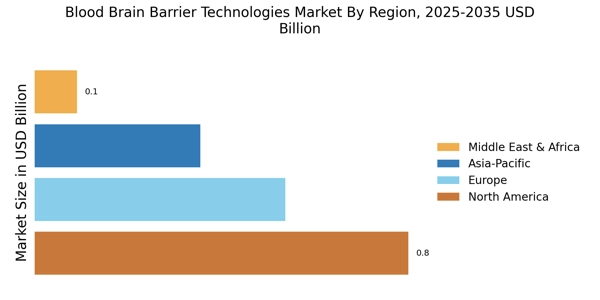Rising Demand for Personalized Medicine
The shift towards personalized medicine is significantly influencing the Blood Brain Barrier Technology Market. As healthcare moves away from a one-size-fits-all approach, there is a growing need for tailored therapies that consider individual patient profiles. This trend is particularly relevant in the treatment of neurological disorders, where genetic and environmental factors play a crucial role in disease manifestation. The development of technologies that can deliver personalized treatments across the blood-brain barrier is becoming increasingly important. Companies are focusing on creating solutions that can adapt to the unique needs of patients, thereby enhancing treatment efficacy. This demand for personalized approaches is expected to drive innovation and growth within the Blood Brain Barrier Technologies Market.
Technological Innovations in Drug Delivery
Technological advancements in drug delivery systems are transforming the Blood Brain Barrier Technology Market. Innovations such as nanoparticles, liposomes, and focused ultrasound are being developed to improve the delivery of therapeutic agents across the blood-brain barrier. These technologies not only enhance the bioavailability of drugs but also minimize side effects, making treatments more effective. The market is experiencing a surge in research and development activities, with companies investing heavily in creating novel delivery mechanisms. For instance, the use of nanotechnology has shown promise in targeting specific brain regions, which could revolutionize treatment protocols. As these technologies mature, they are likely to attract significant attention from investors and healthcare providers, further driving the growth of the Blood Brain Barrier Technologies Market.
Growing Investment in Neuroscience Research
The increasing investment in neuroscience research is a crucial factor influencing the Blood Brain Barrier Technology Market. Governments and private entities are recognizing the importance of understanding the complexities of the brain and the blood-brain barrier. Funding for research initiatives aimed at developing new therapies and technologies is on the rise, with billions allocated annually. This influx of capital is fostering collaboration between academic institutions and industry players, leading to innovative solutions that address the challenges of drug delivery to the brain. As research progresses, the findings are expected to yield breakthroughs that could significantly impact the Blood Brain Barrier Technologies Market, creating new opportunities for growth and development.
Regulatory Support for Innovative Therapies
Regulatory bodies are increasingly supportive of innovative therapies targeting the blood-brain barrier, which is positively impacting the Blood Brain Barrier Technologys Market. Streamlined approval processes and incentives for developing novel drug delivery systems are encouraging pharmaceutical companies to invest in research and development. This regulatory environment fosters innovation, allowing for faster market entry of new therapies that can effectively treat neurological disorders. As regulations evolve to accommodate advancements in technology, the market is likely to see a surge in new products designed to cross the blood-brain barrier. This support not only enhances the potential for successful treatments but also boosts investor confidence in the Blood Brain Barrier Technologies Market.
Increasing Prevalence of Neurological Disorders
The rising incidence of neurological disorders such as Alzheimer's disease, Parkinson's disease, and multiple sclerosis is a primary driver for the Blood Brain Barrier Technologies Market. As the population ages, the demand for effective treatment options intensifies. According to recent estimates, neurological disorders affect millions worldwide, leading to a significant burden on healthcare systems. This situation compels researchers and pharmaceutical companies to explore innovative solutions that can effectively cross the blood-brain barrier. The need for advanced drug delivery systems that can target the central nervous system is becoming increasingly urgent, thereby propelling the growth of the Blood Brain Barrier Technologies Market. The market is projected to witness substantial growth, with investments directed towards developing technologies that enhance drug efficacy and safety in treating these complex conditions.


















Leave a Comment